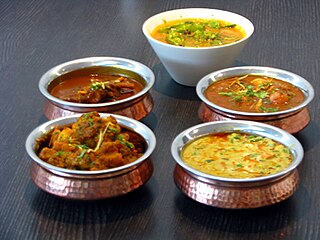
Curry is a variety of dishes originating in the Indian subcontinent that use a complex combination of spices or herbs, usually including ground turmeric, cumin, coriander, ginger, and fresh or dried chilies. In southern India, where the word originated, curry leaves, from the curry tree, are also an integral ingredient. Curry is generally prepared in a sauce.

Couscous is a Maghrebi dish of small steamed balls of crushed durum wheat semolina that is traditionally served with a stew spooned on top. Pearl millet and sorghum, especially in the Sahel, and other cereals can be cooked in a similar way and the resulting dishes are also sometimes called couscous. Pearl or Israeli couscous, properly known as ptitim, is a type of pasta.

Dill is an annual herb in the celery family Apiaceae. It is the only species in the genus Anethum. Dill is grown widely in Eurasia where its leaves and seeds are used as a herb or spice for flavouring food.

Vietnamese cuisine encompasses the foods and beverages of Vietnam, and features a combination of five fundamental tastes in overall meals. Each Vietnamese dish has a distinctive flavor which reflects one or more of these elements. Common ingredients include shrimp paste, fish sauce, bean sauce, rice, fresh herbs, fruit and vegetables. French cuisine has also had a major influence due to the French colonization of Vietnam. Vietnamese recipes use lemongrass, ginger, mint, Vietnamese mint, long coriander, Saigon cinnamon, bird's eye chili, lime, and Thai basil leaves. Traditional Vietnamese cooking is greatly admired for its fresh ingredients, minimal use of dairy and oil, complementary textures, and reliance on herbs and vegetables. It is also low in sugar and is almost always naturally gluten-free, as many of the dishes are made with rice noodles, rice papers and rice flour instead of wheat. With the balance between fresh herbs and meats and a selective use of spices to reach a fine taste, Vietnamese food is considered one of the healthiest cuisines worldwide.
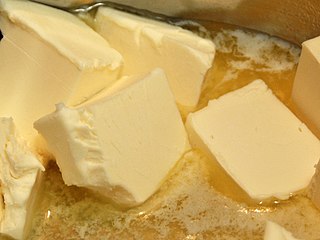
Butter is a dairy product made from the fat and protein components of milk or cream. It is a semi-solid emulsion at room temperature, consisting of approximately 80% butterfat. It is used at room temperature as a spread, melted as a condiment, and used as an ingredient in baking, sauce making, pan frying, and other cooking procedures.
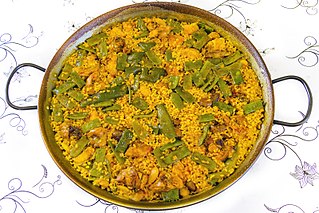
Paella is a Spanish rice dish originally from Valencia.

Gnocchi are a variety of pasta consisting of various thick, small, and soft dough dumplings that may be made from semolina, ordinary wheat flour, egg, cheese, potato, breadcrumbs, cornmeal or similar ingredients, and possibly including flavourings of herbs, vegetables, cocoa or prunes. The dough for gnocchi is most often rolled out before it is cut into small pieces about the size of a wine cork. The little dumplings are then pressed with a fork or a cheese grater to make ridges that can hold sauce. Alternatively, they are simply cut into little lumps. Gnocchi are usually eaten as a replacement for pasta in the first course, but they can also be served as a contorno to some main courses.

Brazilian cuisine is the set of cooking practices and traditions of Brazil, and is characterized by European, Amerindian, African, and most recently Asian influences. It varies greatly by region, reflecting the country's mix of native and immigrant populations, and its continental size as well. This has created a national cuisine marked by the preservation of regional differences.
The Albanian cuisine is a representative of the cuisine of the Mediterranean. It is also an example of the Mediterranean diet based on the importance of olive oil, fruits, vegetables and fish. The cooking traditions of the Albanian people are diverse in consequence of the environmental factors that are more importantly suitable for the cultivation of nearly all kinds of herbs, vegetables and fruits. Olive oil is the most ancient and commonly used vegetable fat in Albanian cooking, produced since antiquity throughout the country particularly along the coasts.

Spätzle[ˈʃpɛtslə](listen), or Knöpfle, also Spätzli or Chnöpfli in Switzerland or Hungarian Nokedli, Csipetke, Galuska or Slovak Halušky or Slovenian Vaseršpacli or vodni žličniki is a type of pasta made with fresh eggs and found in the cuisines of southern Germany and Austria, Switzerland, Hungary, Slovenia, Alsace, Moselle and South Tyrol.

Mashed potato or mashed potatoes, colloquially known as mash, is a dish prepared by mashing boiled potatoes. Milk, butter, salt and pepper are frequently used in preparation. The dish is usually a side dish to meat or vegetables. A similar dish not mashed to total smoothness is known as smashed potatoes.

A tajine or tagine is a North African Maghreb dish which is named after the earthenware pot in which it is cooked. It is also called maraq or marqa.

A chafing dish is a metal cooking or serving pan on a stand with an alcohol burner holding chafing fuel below it. It is used for cooking at table or as a food warmer for keeping dishes at a buffet warm.
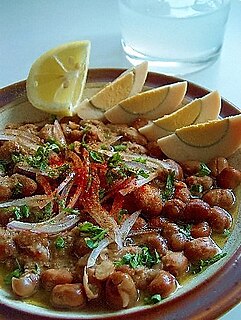
Ful medames, or simply fūl, is a stew of cooked fava beans served with vegetable oil, cumin, and optionally with chopped parsley, garlic, onion, lemon juice, chili pepper and other vegetable, herb and spice ingredients. It is notably a staple food in Egypt, especially in the northern cities of Cairo and Gizah. Ful medames is also a common part of the cuisines of many Arab, Middle Eastern and African cultures, including in Djibouti, Lebanon, Iraq, Syria, Libya, Israel, Palestine, Jordan, Ethiopia, Sudan, Yemen, Somalia and Saudi Arabia.
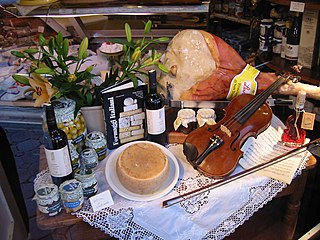
Italian cuisine is a Mediterranean cuisine consisting of the ingredients, recipes and cooking techniques developed across the Italian Peninsula since the antiquity, and later spread around the world together with waves of Italian diaspora.
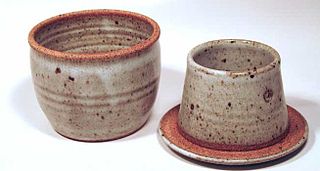
A French butter dish is a container used to maintain the freshness and spreadable consistency of butter without refrigeration. This late 19th century French-designed pottery crock has two parts: a base that holds water, and a cup to hold the packed butter which also serves as a lid. The cup containing butter is placed into the base, where water creates an airtight seal that keeps the air away from the butter so that refrigeration is not needed, and the butter can be used in its soft form. This method will keep butter for around a month provided it is kept at temperatures below 80 °F (27 °C) and the water is changed regularly.
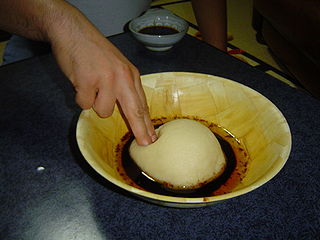
Libyan cuisine derives much from the traditions of Mediterranean, North African, and Berber cuisines. One of the most popular Libyan dishes is Bazin, an unleavened bread prepared with barley, water and salt. Bazin is prepared by boiling barley flour in water and then beating it to create a dough using a magraf, which is a unique stick designed for this purpose. Pork consumption is forbidden, in accordance with Sharia, the religious laws of Islam. Tripoli is Libya's capital, and the cuisine is particularly influenced by Italian cuisine. Pasta is common, and many seafood dishes are available. Southern Libyan cuisine is more traditionally Arab and Berber. Common fruits and vegetables include figs, dates, oranges, apricots and olives.

Puto bumbóng is a Filipino purple rice cake steamed in bamboo tubes. It is traditionally sold during the Christmas season. It is a type of puto.

















